
A look at how Star Wars toys were reworked into other lines,
and vice-versa

A look at how Star Wars toys were reworked into other lines,
and vice-versa
Introduction
 Making a plastic toy isn't easy. It involves conceptual and design work, market research, sculpting or pattern making, and the production of steel tooling,, or the molds used for injection molding plastic. The expense of producing tooling alone is enough to put the production of something like an action figure line beyond the capacity of all but the most prosperous of toy companies. Moreover, the process involved in taking a toy line from the conceptual stages to mass-production requires a lot of time. In fact, it typically takes a full year for the entire process to run its course, a fact which means that a toy company must begin developing its products many months prior to the date they're scheduled to hit store shelves. All this makes economizing a central concern for toy makers-- where corners can be cut without spoiling a product, they are.
Making a plastic toy isn't easy. It involves conceptual and design work, market research, sculpting or pattern making, and the production of steel tooling,, or the molds used for injection molding plastic. The expense of producing tooling alone is enough to put the production of something like an action figure line beyond the capacity of all but the most prosperous of toy companies. Moreover, the process involved in taking a toy line from the conceptual stages to mass-production requires a lot of time. In fact, it typically takes a full year for the entire process to run its course, a fact which means that a toy company must begin developing its products many months prior to the date they're scheduled to hit store shelves. All this makes economizing a central concern for toy makers-- where corners can be cut without spoiling a product, they are.
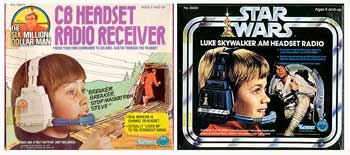 Often this corner cutting takes the form of what I like to call product recycling, or the re-issuing of old toys with new marketing emphases. To a toy company with a large and consistent output, the products it has previously developed are valuable assets. The money invested in them--and in their steel production molds in particular--represents an investment that the company would like to profit from for as long as possible. Consequently, the re-releasing of old products is an option that companies often find very attractive, precisely because it allows for an already-developed product to create new revenue. Why spend money developing an entirely new product when an old one can be slightly modified and released not only with minimal expenditure but in a short amount of time as well? Of course, the ease with which such recycled products are capable of being brought to market means that they are often unimaginative or slightly awkward. But, from a collecting standpoint, that only makes them more interesting.
Often this corner cutting takes the form of what I like to call product recycling, or the re-issuing of old toys with new marketing emphases. To a toy company with a large and consistent output, the products it has previously developed are valuable assets. The money invested in them--and in their steel production molds in particular--represents an investment that the company would like to profit from for as long as possible. Consequently, the re-releasing of old products is an option that companies often find very attractive, precisely because it allows for an already-developed product to create new revenue. Why spend money developing an entirely new product when an old one can be slightly modified and released not only with minimal expenditure but in a short amount of time as well? Of course, the ease with which such recycled products are capable of being brought to market means that they are often unimaginative or slightly awkward. But, from a collecting standpoint, that only makes them more interesting.
Recycled Star Wars: What Is and What Isn't
In the realm of Star Wars toys, principle licensee Kenner recycled many products. The company's recycled Star Wars output falls into two basic categories: 1) toys from the early '70s that were re-issued with a new Star Wars bent, and 2) toys developed specifically for the Star Wars line, which were later re-issued with slight modifications as parts of lines such as Batman and Robin Hood: Prince of Thieves. For Kenner as for any other toy company, the benefits of recycling past products were obvious-- minimal developmental cost and nearly instantaneous production capability.
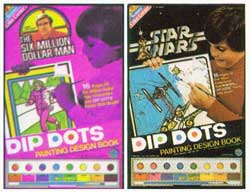 Instantaneous production capability, or the ability to skip the developmental process entirely and move immediately into mass-production, must have been a chief reason for Kenner's having recycled so many products early in their involvement with Star Wars. Although they had signed-on to produce Star Wars toys before the film debuted, very little was invested in development before May of 1977-- after all, no one expected the film to do as well as it did. Once Star Wars proved itself a mega-hit, Kenner immediately went into over-drive, developing Star Wars toys as fast as resources would allow, in hopes of having product ready for Toy Fair in early 1978. This lack of adequate time in which to produce a well-rounded product line was one factor behind Kenner's reliance on recycled toys. Another was the sheer enormity of Star Wars' popularity. Indeed, the film was so popular during the last three years of the '70s that nearly anything with the Star Wars moniker stamped across it would have sold. For this reason, Kenner adapted many of its most successful mainstay products to the Star Wars license. While, unfortunately, the world never got to see the Princess Leia Easy Bake Oven, Playdoh, the Give-a-Show Projector, Kenner's crank-operated movie projector and the color sets known as Playnts and Dip Dots all received the Star Wars treatment. But since these products were specifically designed to be adapted to different themes and licenses, they don't really conform to our topic. In truth, Kenner issued a Playdoh set for nearly every successful license they held over a period of nearly 30 years, so Star Wars wasn't special in that respect.
Instantaneous production capability, or the ability to skip the developmental process entirely and move immediately into mass-production, must have been a chief reason for Kenner's having recycled so many products early in their involvement with Star Wars. Although they had signed-on to produce Star Wars toys before the film debuted, very little was invested in development before May of 1977-- after all, no one expected the film to do as well as it did. Once Star Wars proved itself a mega-hit, Kenner immediately went into over-drive, developing Star Wars toys as fast as resources would allow, in hopes of having product ready for Toy Fair in early 1978. This lack of adequate time in which to produce a well-rounded product line was one factor behind Kenner's reliance on recycled toys. Another was the sheer enormity of Star Wars' popularity. Indeed, the film was so popular during the last three years of the '70s that nearly anything with the Star Wars moniker stamped across it would have sold. For this reason, Kenner adapted many of its most successful mainstay products to the Star Wars license. While, unfortunately, the world never got to see the Princess Leia Easy Bake Oven, Playdoh, the Give-a-Show Projector, Kenner's crank-operated movie projector and the color sets known as Playnts and Dip Dots all received the Star Wars treatment. But since these products were specifically designed to be adapted to different themes and licenses, they don't really conform to our topic. In truth, Kenner issued a Playdoh set for nearly every successful license they held over a period of nearly 30 years, so Star Wars wasn't special in that respect.
The Bionic Connection
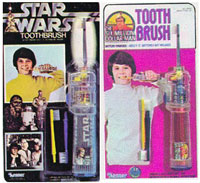 More interesting are Star Wars toys that were re-issues of past Kenner products that were unique, or even tied to another license. Kenner's popular Six Million Dollar Man line, for instance, was the source of two interesting Star Wars products, both of which debuted in the time-strapped year of 1978. One of these, the Star Wars electric toothbrush, derived from a similar product, which had first been sold as a part of both the Bionic Woman and Six Million Dollar Man lines. Possessing an outer casing of clear plastic, through which colorful paper inserts could be seen, the toothbrush was easily given a new emphasis-- the paper inserts were simply re-printed with Star Wars rather than Bionic themed graphics. Additionally, the design of the toothbrush was highly amenable to the Star Wars universe. Not only did it emulate the shape of a lightsaber hilt, the two plastic brush extensions it came packaged with could, with a little imagination, be accepted as two differently colored lightsaber beams.
More interesting are Star Wars toys that were re-issues of past Kenner products that were unique, or even tied to another license. Kenner's popular Six Million Dollar Man line, for instance, was the source of two interesting Star Wars products, both of which debuted in the time-strapped year of 1978. One of these, the Star Wars electric toothbrush, derived from a similar product, which had first been sold as a part of both the Bionic Woman and Six Million Dollar Man lines. Possessing an outer casing of clear plastic, through which colorful paper inserts could be seen, the toothbrush was easily given a new emphasis-- the paper inserts were simply re-printed with Star Wars rather than Bionic themed graphics. Additionally, the design of the toothbrush was highly amenable to the Star Wars universe. Not only did it emulate the shape of a lightsaber hilt, the two plastic brush extensions it came packaged with could, with a little imagination, be accepted as two differently colored lightsaber beams.
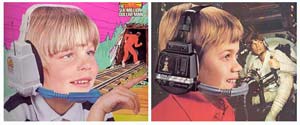 The second Star Wars toy to be developed out of Kenner's twin Bionic lines was the infamous Star Wars AM Headset Radio. The tooling for the plastic casing of the radio was actually created for the Six Million Dollar Man CB Headset Radio Receiver, a product that Kenner had offered as recently as one-year prior, in 1977. But by 1978 the CB radio fad had wound down enough to prompt Kenner to replace the CB circuitry of its product with an AM radio receiver. The resulting Star Wars headset radio is more renowned today for its rarity than for its inventiveness as a toy, but Kenner's conversion of the rather nifty-looking product wasn't unwarranted-- the unit looked marginally like the small headsets worn by Luke and Han during their manning of the Millennium Falcon's guns. Moreover, the toy's package, showing Luke poised for action in one of the Falcon's gunner chairs, is one of the most striking of the vintage Star Wars era.
The second Star Wars toy to be developed out of Kenner's twin Bionic lines was the infamous Star Wars AM Headset Radio. The tooling for the plastic casing of the radio was actually created for the Six Million Dollar Man CB Headset Radio Receiver, a product that Kenner had offered as recently as one-year prior, in 1977. But by 1978 the CB radio fad had wound down enough to prompt Kenner to replace the CB circuitry of its product with an AM radio receiver. The resulting Star Wars headset radio is more renowned today for its rarity than for its inventiveness as a toy, but Kenner's conversion of the rather nifty-looking product wasn't unwarranted-- the unit looked marginally like the small headsets worn by Luke and Han during their manning of the Millennium Falcon's guns. Moreover, the toy's package, showing Luke poised for action in one of the Falcon's gunner chairs, is one of the most striking of the vintage Star Wars era.
Cheesier Territory: SSP Vans and X-Wing Aces
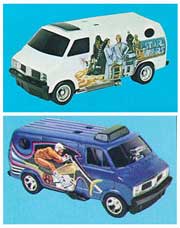 Although both the electric toothbrush and headset radio proved quite adaptable to George Lucas's universe, the two other recycled products in Kenner's original Star Wars line were somewhat less compatible with the Star Wars aesthetic. Indeed, they looked like exactly what they were-- unrelated products that had been given rather shoddy Star Wars makeovers. The more familiar of these toys are the two Star Wars SSP vans. Short for "super sonic power," the SSP line was centered on vehicles that could be made to move via a "T-stick" pull device. Seeing the opportunity to reanimate an old concept by affiliating it with an ultra-hot film, Kenner simply decorated their existing SSP van with some flashy decals, and the Star Wars SSP van was born. Two van styles were available, a black one for the villains and a white one for the heroes, and they were sold both separately and together in a stunt set. But any way you look at it, they were pure cheese, and one of the less inspired Star Wars products released by Kenner.
Although both the electric toothbrush and headset radio proved quite adaptable to George Lucas's universe, the two other recycled products in Kenner's original Star Wars line were somewhat less compatible with the Star Wars aesthetic. Indeed, they looked like exactly what they were-- unrelated products that had been given rather shoddy Star Wars makeovers. The more familiar of these toys are the two Star Wars SSP vans. Short for "super sonic power," the SSP line was centered on vehicles that could be made to move via a "T-stick" pull device. Seeing the opportunity to reanimate an old concept by affiliating it with an ultra-hot film, Kenner simply decorated their existing SSP van with some flashy decals, and the Star Wars SSP van was born. Two van styles were available, a black one for the villains and a white one for the heroes, and they were sold both separately and together in a stunt set. But any way you look at it, they were pure cheese, and one of the less inspired Star Wars products released by Kenner.
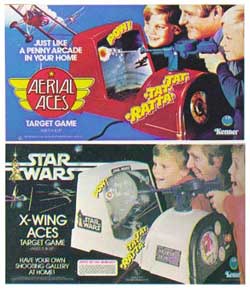 But as bad as the vans were, the one remaining recycled toy from the original Star Wars line, the X-Wing Aces Target Game, gets my vote as the most incongruous of all Kenner Star Wars toys. Advertised as being "just like a shooting gallery in your own home," the large, arcade-style unit was a thinly veiled remake of the earlier Aerial Aces game, which utilized a video screen and a very un-Star Wars machine gun to simulate a World War I era dog fight. But where Aerial Aces required its players to shoot down miniature bi-planes, X-Wing Aces presented them with TIE Fighters. Additionally, the red outer casing of the earlier toy was abandoned in favor of a more subdued light gray, and some Star Wars-themed stickers were added to it. Despite these changes, I don't believe X-Wing Aces was very well received. On today's collectors market, the toy is one of the least frequently seen Kenner items, indicating that relatively few of the units were produced and sold at retail. But from a manufacturer's standpoint, that's one of the beauties of recycled products-- since virtually nothing was invested in developing X-Wing Aces, any business generated by the toy was a bonus; it was no big deal if it didn't sell like wildfire.
But as bad as the vans were, the one remaining recycled toy from the original Star Wars line, the X-Wing Aces Target Game, gets my vote as the most incongruous of all Kenner Star Wars toys. Advertised as being "just like a shooting gallery in your own home," the large, arcade-style unit was a thinly veiled remake of the earlier Aerial Aces game, which utilized a video screen and a very un-Star Wars machine gun to simulate a World War I era dog fight. But where Aerial Aces required its players to shoot down miniature bi-planes, X-Wing Aces presented them with TIE Fighters. Additionally, the red outer casing of the earlier toy was abandoned in favor of a more subdued light gray, and some Star Wars-themed stickers were added to it. Despite these changes, I don't believe X-Wing Aces was very well received. On today's collectors market, the toy is one of the least frequently seen Kenner items, indicating that relatively few of the units were produced and sold at retail. But from a manufacturer's standpoint, that's one of the beauties of recycled products-- since virtually nothing was invested in developing X-Wing Aces, any business generated by the toy was a bonus; it was no big deal if it didn't sell like wildfire.
The ESB Years: the Real West and Glamour Gals
Kenner's conversion of older products into Star Wars toys all but ended after 1979. By the time The Empire Strikes Back rolled around in 1980, the company had begun to hit full stride with its Star Wars line. With adequate time to plan and produce the new toys, Kenner was able to debut with a sizable selection of ESB product; and since they had initiated development early, before the film hit theaters, they were able to release new products regularly throughout the entire year. Thus, recycling products into the Star Wars line was neither necessary nor desirable. However, Kenner did issue two recycled toys during the ESB years that had a definite relationship to Star Wars-- both were nothing more than first generation Star Wars toys that had been re-worked into other Kenner lines. Although both of these items are very rare, and are known to most hobbyists only through Kenner catalog imagery, they nevertheless are the most attractive recycled products in the eyes of the typical Star Wars collector, a status that is surely due to their immediate familiarity to anyone possessing a basic knowledge of Star Wars toys.
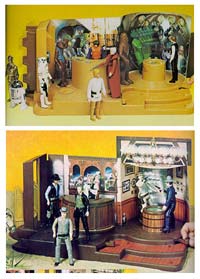 The first of these products was 1980's Western Café playset from the Real West line. A short-lived and rather unsuccessful venture, the Real West was itself a recycled concept of sorts-it had begun in 1979, as a tie-in to the film Butch and Sundance: The Early Years. When the movie bombed, Kenner simply expanded the line's focus to encompass the quasi-mythical characters of the American old west and marketed it under a broader title. In order to bulk up the line and maintain retailer attention, Kenner recycled the base of their Star Wars Creature Cantina playset, transforming it into the principal component of a new Western themed saloon toy. Although the Western Café's derivation is easily discernible, Kenner's modifications to the Creature Cantina were extensive as well as effective. For one thing, the base was molded in a dark brown color rather than the yellowish hue of the Star Wars original. For another, an original cardboard backdrop, complete with a bartender and chandelier overhang, was developed, which contributed substantially to the western "feel" of the toy. Stickers imitating clapboard surfaces and a nifty pair of swinging doors completed the transformation. Not only was the resulting playset successful in its own right, it made a pointed, though unintentional, comment on the appeal of Star Wars in general. Just as Lucas had transformed the saloon environment of the western film genre into his otherworldly Tatooine cantina, Kenner now returned it to its origins, transforming their Star Wars Creature Cantina into a toy of purely western implications.
The first of these products was 1980's Western Café playset from the Real West line. A short-lived and rather unsuccessful venture, the Real West was itself a recycled concept of sorts-it had begun in 1979, as a tie-in to the film Butch and Sundance: The Early Years. When the movie bombed, Kenner simply expanded the line's focus to encompass the quasi-mythical characters of the American old west and marketed it under a broader title. In order to bulk up the line and maintain retailer attention, Kenner recycled the base of their Star Wars Creature Cantina playset, transforming it into the principal component of a new Western themed saloon toy. Although the Western Café's derivation is easily discernible, Kenner's modifications to the Creature Cantina were extensive as well as effective. For one thing, the base was molded in a dark brown color rather than the yellowish hue of the Star Wars original. For another, an original cardboard backdrop, complete with a bartender and chandelier overhang, was developed, which contributed substantially to the western "feel" of the toy. Stickers imitating clapboard surfaces and a nifty pair of swinging doors completed the transformation. Not only was the resulting playset successful in its own right, it made a pointed, though unintentional, comment on the appeal of Star Wars in general. Just as Lucas had transformed the saloon environment of the western film genre into his otherworldly Tatooine cantina, Kenner now returned it to its origins, transforming their Star Wars Creature Cantina into a toy of purely western implications.
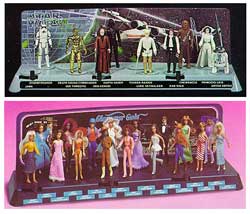 The second Kenner Star Wars product to be recycled into another toy line was the Action Display Stand. Consisting of a gray plastic base and a rectangular cardboard backdrop, the stand had been designed for the first 12 Star Wars figures. But as only its backdrop referred explicitly to Star Wars, it was ideal for recycling-- by simply changing the graphics on the backdrop, a relatively inexpensive procedure, the entire focus of the toy could be shifted. The line into which Kenner inserted their recycled figure stand was the Glamour Gals line of miniature fashion dolls. Since the 4" scale of the Glamour Gals was comparable to that of the Star Wars line, the fashion figures were right at home on the display stand. Moreover, the rather tame "action" feature of the stand, a series of movable discs on which the figures could be stood and partially rotated, made the Glamour Gals appear to pose and model their outfits. The differences of the Glamour Gals stand vis-à-vis its Star Wars counterpart were striking: not only was the focus of the backdrop changed from a space scene to a city skyline, the base was molded in black plastic instead of the familiar gray. Additionally, the capacity of the rectangular base was expanded from 12 to 15 figures, meaning a mold change was necessary to produce the toy. Unfortunately, the Glamour Gals Fashion Stand is exceedingly rare: I've only seen a couple of examples of the item, which was available solely as a mail-away premium.
The second Kenner Star Wars product to be recycled into another toy line was the Action Display Stand. Consisting of a gray plastic base and a rectangular cardboard backdrop, the stand had been designed for the first 12 Star Wars figures. But as only its backdrop referred explicitly to Star Wars, it was ideal for recycling-- by simply changing the graphics on the backdrop, a relatively inexpensive procedure, the entire focus of the toy could be shifted. The line into which Kenner inserted their recycled figure stand was the Glamour Gals line of miniature fashion dolls. Since the 4" scale of the Glamour Gals was comparable to that of the Star Wars line, the fashion figures were right at home on the display stand. Moreover, the rather tame "action" feature of the stand, a series of movable discs on which the figures could be stood and partially rotated, made the Glamour Gals appear to pose and model their outfits. The differences of the Glamour Gals stand vis-à-vis its Star Wars counterpart were striking: not only was the focus of the backdrop changed from a space scene to a city skyline, the base was molded in black plastic instead of the familiar gray. Additionally, the capacity of the rectangular base was expanded from 12 to 15 figures, meaning a mold change was necessary to produce the toy. Unfortunately, the Glamour Gals Fashion Stand is exceedingly rare: I've only seen a couple of examples of the item, which was available solely as a mail-away premium.
A Long Haired Indy and Treetot Ewoks?
In the years immediately following 1982 there was little action on the recycled Star Wars toy front. As had been the case with their Empire Strikes Back releases, Kenner's Return of the Jedi line of 1983 and 1984 was well-conceived and planned far enough in advance to make issuing recycled toys under the Star Wars banner unnecessary. Furthermore, Kenner's other action figure lines of the time--Super Powers, M.A.S.K., The Adventures of Indiana Jones--were not so amenable to the scale and look of Star Wars, meaning that little could be transferred out of one line and into another.
 Yet a two products from this era do fit into our theme, though one does so only in a marginal way. The first of these is the 12" Indiana Jones action figure, the only toy of this scale that was released in the Adventures of Indiana Jones line of late '82 and '83. The head and body of the doll were produced using molds originally created for the Han Solo large size action figure of 1979. Although the molded "hair" of the head was too long and, well, '70s-looking to accurately represent the short Depression-era hairstyle seen on Indiana Jones in Raiders of the Lost Ark, the face was a wonderful representation of Harrison Ford. The two dolls differed only in the ways in which their heads were painted: whereas the Han doll had brown eyes and reddish hair, the Indy had blue eyes and browner hair. It is highly unlikely that Kenner would have made a 12" Indiana Jones figure had they been faced with the expensive proposition of creating it from scratch. So not only did Harrison Ford's portrayal of the Han Solo character pave the way for his assumption of the role of Indiana Jones, the doll version of Han Solo literally became the Indiana Jones doll.
Yet a two products from this era do fit into our theme, though one does so only in a marginal way. The first of these is the 12" Indiana Jones action figure, the only toy of this scale that was released in the Adventures of Indiana Jones line of late '82 and '83. The head and body of the doll were produced using molds originally created for the Han Solo large size action figure of 1979. Although the molded "hair" of the head was too long and, well, '70s-looking to accurately represent the short Depression-era hairstyle seen on Indiana Jones in Raiders of the Lost Ark, the face was a wonderful representation of Harrison Ford. The two dolls differed only in the ways in which their heads were painted: whereas the Han doll had brown eyes and reddish hair, the Indy had blue eyes and browner hair. It is highly unlikely that Kenner would have made a 12" Indiana Jones figure had they been faced with the expensive proposition of creating it from scratch. So not only did Harrison Ford's portrayal of the Han Solo character pave the way for his assumption of the role of Indiana Jones, the doll version of Han Solo literally became the Indiana Jones doll.
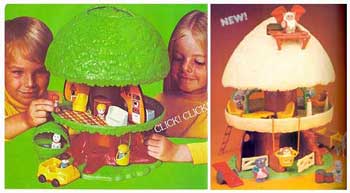 One additional product from this era marginally fits into our theme-- the Ewok Family Hut from Kenner's Preschool line. Although, in terms of design, the Ewok toy borrowed extensively from Kenner's very successful Treetot house, it was entirely retooled. According to Kenner sources, Lucasfilm would not allow the toy company to tie a purely recycled version of the Treetot product to their license. So Kenner totally resculpted the toy. In the end, the Ewok Family Hut borrowed the basic design and interior workings of the older toy and simply cloaked them in an updated outer casing. Still, the similarities between the two items are numerous and too obvious to ignore. Even though only four or so people actually collect the preschool Ewoks line, it's still nice to know what served as the basis for the woodland condo of everyone's favorite fuzzy family.
One additional product from this era marginally fits into our theme-- the Ewok Family Hut from Kenner's Preschool line. Although, in terms of design, the Ewok toy borrowed extensively from Kenner's very successful Treetot house, it was entirely retooled. According to Kenner sources, Lucasfilm would not allow the toy company to tie a purely recycled version of the Treetot product to their license. So Kenner totally resculpted the toy. In the end, the Ewok Family Hut borrowed the basic design and interior workings of the older toy and simply cloaked them in an updated outer casing. Still, the similarities between the two items are numerous and too obvious to ignore. Even though only four or so people actually collect the preschool Ewoks line, it's still nice to know what served as the basis for the woodland condo of everyone's favorite fuzzy family.
Post '86: the Afterlife of Star Wars Toys
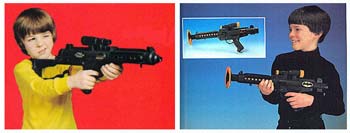 The Star Wars line wound to an end in 1986 when the last of the Droids and Ewoks figures hit store shelves and quickly entered clearance bins. Following the denouement of the long successful and much loved toy line, a long fallow period ensued, during which little resembling Star Wars was available to toy consumers. That would change, of course, in 1995, when Hasbro reemerged with a whole new line of Star Wars action figures. Before that event, however, those familiar with the classic Kenner toys were treated to some toy-based déjà vu in the form of several recycled Star Wars toys. These products were all tied to two of the bigger blockbuster films of the period, Batman and Robin Hood: Prince of Thieves, both of which had companion Kenner action figures lines created for them. The Robin Hood line in particular was a virtual goldmine of recycled Star Wars product.
The Star Wars line wound to an end in 1986 when the last of the Droids and Ewoks figures hit store shelves and quickly entered clearance bins. Following the denouement of the long successful and much loved toy line, a long fallow period ensued, during which little resembling Star Wars was available to toy consumers. That would change, of course, in 1995, when Hasbro reemerged with a whole new line of Star Wars action figures. Before that event, however, those familiar with the classic Kenner toys were treated to some toy-based déjà vu in the form of several recycled Star Wars toys. These products were all tied to two of the bigger blockbuster films of the period, Batman and Robin Hood: Prince of Thieves, both of which had companion Kenner action figures lines created for them. The Robin Hood line in particular was a virtual goldmine of recycled Star Wars product.
In contrast, Star Wars' presence within the Batman line was fairly negligible. Although there were plenty of interesting gadgets in the original Batman film on which Kenner could have based role-play toys, they instead chose to issue a modified version of a pre-existing Star Wars item as their principal Bat-weapon. The Star Wars item utilized was Kenner's very familiar electronic rifle, a toy that had originally been marketed as the Three Position Laser Rifle and had later been re-issued in abbreviated form as the Electronic Laser Rifle. Perhaps in deference to prevailing PC attitudes, the toy, as it was issued under the Batman banner, was re-christened the Sonic Neutralizer and its muzzle was capped with a rather impotent-looking, bat-emblazoned dish. Furthermore, a Bat Symbol replaced the old Star Wars or ESB logo and the sight--all black on the Star Wars toy--was embellished with some bright gold capping elements. But the distinctive shape of the gun was more than enough to betray its origin to any former Star Wars-obsessed child.
Robin Hood: Prince of Thieves
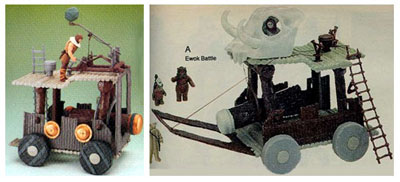 The final and most extensive regeneration of the classic Star Wars toy within the context of another product line occurred in 1992, with Kenner's release of their toys for the Kevin Costner vehicle, Robin Hood: Prince of Thieves. Much of the film was set in the legendary Sherwood Forest, in the treetop lair of Robin Hood's band, and the bulk of Kenner's line was focused on this woodland environment. But despite the prominence of Sherwood Forest in the film, Kenner's focus on it served another purpose; namely, it provided them with the opportunity to re-release several Return of the Jedi and Power of the Force toys, which had originally been developed as accessories to Kenner's many Ewok figures. All in all, a full 50% of the accessories in the Robin Hood line were recycled products; of four total figure-related toys, two, the Battle Wagon and Sherwood Forest Playset, were drawn from Star Wars. An action figure was even recycled, the only instance in which a figure developed for Star Wars was adapted to another property.
The final and most extensive regeneration of the classic Star Wars toy within the context of another product line occurred in 1992, with Kenner's release of their toys for the Kevin Costner vehicle, Robin Hood: Prince of Thieves. Much of the film was set in the legendary Sherwood Forest, in the treetop lair of Robin Hood's band, and the bulk of Kenner's line was focused on this woodland environment. But despite the prominence of Sherwood Forest in the film, Kenner's focus on it served another purpose; namely, it provided them with the opportunity to re-release several Return of the Jedi and Power of the Force toys, which had originally been developed as accessories to Kenner's many Ewok figures. All in all, a full 50% of the accessories in the Robin Hood line were recycled products; of four total figure-related toys, two, the Battle Wagon and Sherwood Forest Playset, were drawn from Star Wars. An action figure was even recycled, the only instance in which a figure developed for Star Wars was adapted to another property.
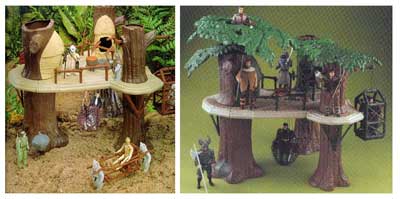 In contrast to the rather lackluster Batman Sonic Neutralizer, all of Kenner's recycled Robin Hood product was conceived with real ingenuity; none of the adapted Star Wars toys seemed out of place or conceptually weak. The largest of them, the Sherwood Forest Playset, was a significantly altered rendition of the Ewok Village playset of 1983. In many ways, the Return of the Jedi toy was absolutely perfect for the Robin Hood line. Not only did the merry men of the film occupy a treetop fortress very similar to that of the Ewoks in its composition of huts and platforms, the various net traps and pulley-operated action features of the Ewok Village playset were ideal for approximating the booby traps utilized in the Robin Hood film. Kenner's changes to the toy were simple but very effective. Firstly, they got rid of the inappropriate fire pit and spit of the Ewok Village, as well as its primitive throne, in which C-3PO was meant to be carried about by Ewoks. Secondly, in order to make the bare trunks of the toy's trees appear more lifelike, a thin garnish of plastic was added to their tops in imitation of leafy greenery. Finally, some slight paint changes and four railing-mounted spear launchers completed Kenner's transformation of their Endorian village into a convincing medieval hideout. Although it is somewhat debatable as to which playset was more successful, the Robin Hood or the Ewok, I think it's indisputable that the "leaves" of the later toy represented a substantial improvement. And, let's face it, take Ewoks out of the equation and any toy is improved.
In contrast to the rather lackluster Batman Sonic Neutralizer, all of Kenner's recycled Robin Hood product was conceived with real ingenuity; none of the adapted Star Wars toys seemed out of place or conceptually weak. The largest of them, the Sherwood Forest Playset, was a significantly altered rendition of the Ewok Village playset of 1983. In many ways, the Return of the Jedi toy was absolutely perfect for the Robin Hood line. Not only did the merry men of the film occupy a treetop fortress very similar to that of the Ewoks in its composition of huts and platforms, the various net traps and pulley-operated action features of the Ewok Village playset were ideal for approximating the booby traps utilized in the Robin Hood film. Kenner's changes to the toy were simple but very effective. Firstly, they got rid of the inappropriate fire pit and spit of the Ewok Village, as well as its primitive throne, in which C-3PO was meant to be carried about by Ewoks. Secondly, in order to make the bare trunks of the toy's trees appear more lifelike, a thin garnish of plastic was added to their tops in imitation of leafy greenery. Finally, some slight paint changes and four railing-mounted spear launchers completed Kenner's transformation of their Endorian village into a convincing medieval hideout. Although it is somewhat debatable as to which playset was more successful, the Robin Hood or the Ewok, I think it's indisputable that the "leaves" of the later toy represented a substantial improvement. And, let's face it, take Ewoks out of the equation and any toy is improved.
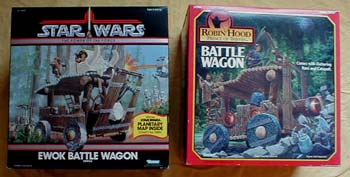 The two additional Star Wars toys that were recycled into the Robin Hood line were the Ewok catapult and Ewok Battle Wagon. Oddly enough, both of these items appeared as components of the same product, the Robin Hood Battle Wagon. Kenner's modifications to the Ewok toy were fairly extensive. Most obviously, they added bronze plastic shield accessories to the notches along the Battle Wagon's side walls, changed the color of the battering ram's face from white to bronze, and added plastic strips to the wheels and battering ram in simulation of riveted straps of steel. Additionally, the colors of some of the plastic parts were altered and plastic details were added to the roof of the vehicle on which the catapult could be mounted. Aside from some color modifications, the catapult that was included with the Robin Hood Battle Wagon appears to be virtually unchanged from the one released as part of the Return of the Jedi line.
The two additional Star Wars toys that were recycled into the Robin Hood line were the Ewok catapult and Ewok Battle Wagon. Oddly enough, both of these items appeared as components of the same product, the Robin Hood Battle Wagon. Kenner's modifications to the Ewok toy were fairly extensive. Most obviously, they added bronze plastic shield accessories to the notches along the Battle Wagon's side walls, changed the color of the battering ram's face from white to bronze, and added plastic strips to the wheels and battering ram in simulation of riveted straps of steel. Additionally, the colors of some of the plastic parts were altered and plastic details were added to the roof of the vehicle on which the catapult could be mounted. Aside from some color modifications, the catapult that was included with the Robin Hood Battle Wagon appears to be virtually unchanged from the one released as part of the Return of the Jedi line.
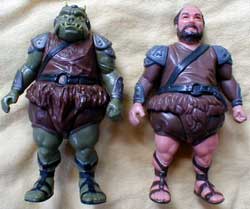 The one recycled Kenner Star Wars product to have remained unmentioned up to this point is also one of the most interesting: the Friar Tuck action figure. Since the Friar Tuck character in the Robin Hood film was always shown garbed beneath a baggy brown robe, Kenner must have determined that the details of his body could be fudged somewhat. Besides, what kid in his right mind would want to go peeking under the fat friar's robe? Consequently, they decided to base the body on that of an existing figure, namely the Gamorrean Guard from their Return of the Jedi line of 1983. Not only did the Gamorrean figure have the physical bulk required for a metamorphoses into Friar Tuck, its primitive sandals and hairy garments translated well into medieval footwear and skivvies, respectively. However, close comparison of the two figures reveals that their bodies bear significant differences. Specifically, much of the Gamorrean's rather roughly sculpted details were smoothed out on the Tuck figure, and several significant modifications were made, including the removal of the Gamorrean's chest plate and the addition on the Tuck figure of a knife, which appears on the character's belt. So, the Gamorrean body did not serve directly as the basis for Friar Tuck. It's possible that Kenner merely based their sculpt of the Tuck figure on the older Gamorrean. But, nevertheless, the close relationship between the two toys is indisputable.
The one recycled Kenner Star Wars product to have remained unmentioned up to this point is also one of the most interesting: the Friar Tuck action figure. Since the Friar Tuck character in the Robin Hood film was always shown garbed beneath a baggy brown robe, Kenner must have determined that the details of his body could be fudged somewhat. Besides, what kid in his right mind would want to go peeking under the fat friar's robe? Consequently, they decided to base the body on that of an existing figure, namely the Gamorrean Guard from their Return of the Jedi line of 1983. Not only did the Gamorrean figure have the physical bulk required for a metamorphoses into Friar Tuck, its primitive sandals and hairy garments translated well into medieval footwear and skivvies, respectively. However, close comparison of the two figures reveals that their bodies bear significant differences. Specifically, much of the Gamorrean's rather roughly sculpted details were smoothed out on the Tuck figure, and several significant modifications were made, including the removal of the Gamorrean's chest plate and the addition on the Tuck figure of a knife, which appears on the character's belt. So, the Gamorrean body did not serve directly as the basis for Friar Tuck. It's possible that Kenner merely based their sculpt of the Tuck figure on the older Gamorrean. But, nevertheless, the close relationship between the two toys is indisputable.
Conclusion: Is There Anything Else?
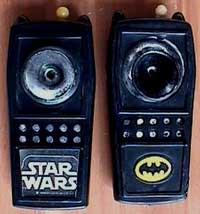 This ends our (rather lengthy) look into the fascinating world of recycled Kenner Star Wars product. But before closing this article out, I must mention a few more products which at least marginally fit into the topic. First is a walkie-talkie, issued in the late '70s by Kenner Canada as a component of their ultra-cheap, super-rare Princess Leia utility belt set. This plastic doo-dad was originally issued in a similar Batman role-play set. The two toys differ only in their decals: one is decorated with the Bat Symbol, the other with the Star Wars logo. And, finally, there is the Sundance Kid figure, issued as part of both the Butch and Sundance and Real West product lines. As collector Andy Loney has noted, the head of the figure bears a striking resemblance to the noggins of both the Original and Bespin Luke Skywalker figures, issued in late 1977 and 1980, respectively. Ostensibly, the Sundance head differs from the two Lukes in the presence of a cowboy hat on top of its hair and a mustache on its face. Upon closer scrutiny, however, one notices several more subtle differences concerning the lines that delineate the figure's hair, as well as in the "flesh" surrounding the chin. Might this be another instance, similar to the case involving the Gamorrean Guard and Friar Tuck figures, of Kenner having used an existing figure as the basis for a new one? I'll leave that determination to the reader.
This ends our (rather lengthy) look into the fascinating world of recycled Kenner Star Wars product. But before closing this article out, I must mention a few more products which at least marginally fit into the topic. First is a walkie-talkie, issued in the late '70s by Kenner Canada as a component of their ultra-cheap, super-rare Princess Leia utility belt set. This plastic doo-dad was originally issued in a similar Batman role-play set. The two toys differ only in their decals: one is decorated with the Bat Symbol, the other with the Star Wars logo. And, finally, there is the Sundance Kid figure, issued as part of both the Butch and Sundance and Real West product lines. As collector Andy Loney has noted, the head of the figure bears a striking resemblance to the noggins of both the Original and Bespin Luke Skywalker figures, issued in late 1977 and 1980, respectively. Ostensibly, the Sundance head differs from the two Lukes in the presence of a cowboy hat on top of its hair and a mustache on its face. Upon closer scrutiny, however, one notices several more subtle differences concerning the lines that delineate the figure's hair, as well as in the "flesh" surrounding the chin. Might this be another instance, similar to the case involving the Gamorrean Guard and Friar Tuck figures, of Kenner having used an existing figure as the basis for a new one? I'll leave that determination to the reader.
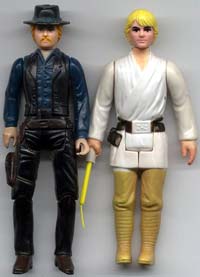
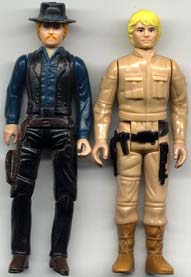
As I hope I've pointed out, examining the way in which these toys were changed and re-issued can be both illuminating and fun. But recycled toys can also be fun (not to mention challenging) to collect. So, if you find this kind of thing interesting, get out there to the flea market or log onto eBay, and start searching. And if you find a recycled Star Wars product that is not mentioned here, drop me a line. (And don't forget that I'm still looking for that Glamour Gals display stand!) Happy hunting!